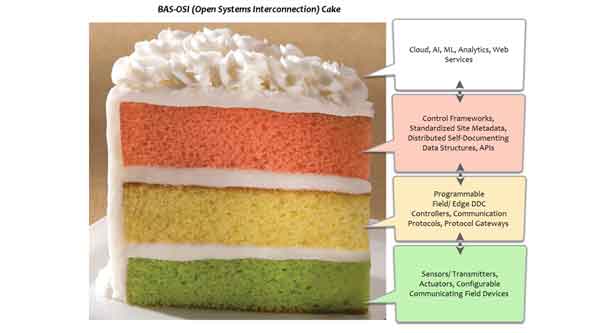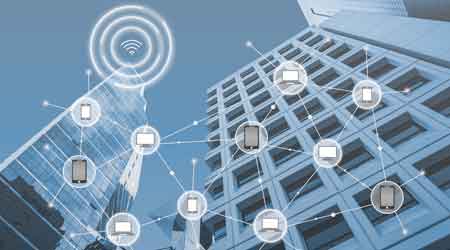« Back to Facilities Management Building Automation Category Home
Building Automation: What Does Open Mean?
April 3, 2020
- Building Automation
By Ken Sinclair
The word "open" means different things to different people, and the word’s meaning is defined by the audience and its interests. At AHR Expo in Orlando we held a very successful open discussion for an open future. It was a presentation by our young contributing editors, our dream team for open thinking. Here is a link to the session PDF and video recording of the complete session. Great thought leadership for the industry. Great session: I had to sit on the floor because the room was full to overflowing. Fun times with thoughts being shared globally. Good interest in us all learning what open means.
My last column was titled “Born Again Connected.” This session showed us that means also being born again open, which Generation Z just expects.
Our contributing editor Zach Netsov, product specialist, Contemporary Controls, was part of this very successful session. Check out his article, “Open” Means Different Things to Different People. “It is actually very simple. Interoperability is something that users must demand. Nothing will change until end users such as building owners, specifying engineers, or systems integrators demand interoperability. They need to know what “open” means and vote for that with their dollar. After all, our buying power is the most powerful voting power that we possess. We vote with our dollar for all kinds of things every day. In another scenario where full interoperability makes its way into the BAS industry is a massive disruption. A massive disruption to the industry would be if a manufacturer offers truly ‘open’ automation solutions, all other companies would have to follow or perish.
He created the following graphic to illustrate the concept of interoperability using a layer cake. He explains: "Basically, you would need all of the cake layers to interoperate for you to get to the 'icing on the cake' which is what we want these days with cloud and IoT – AI, ML, analytics, web services, global access, etc."

We have been at this for a while. An article from 2010 by Nirosha Munasinghe, product development manager, Open General, says: “The word ‘Open’ is a very powerful word in the English language. It can be argued that the word ‘Open’ is the most fundamental key word that has driven the BAS industry over the last decade and will continue to drive it in the future. Open standards, open protocols, open architecture, and open web are some of the key concepts in the BAS industry. The Oxford dictionary defines open as allowing access, passage, or a view through empty space; not closed or blocked. Each one of us interprets the meaning in many ways. This is no different in the BAS industry. Therefore, although ‘open’ has driven the BAS industry, it also has created confusion. This article unveils the intricacies of the word ‘open’ in the BAS industry and defines key elements that the stakeholders need to be aware of when interpreting the word ‘open.’”
Here are some recent takes on the concept of open.
Open or closed? Can Bill Gates and Microsoft make it right the second time? — Nicolas Waern, "The IoT - Building Whisperer." He says: “‘Proprietary’ should really be an enhancement in functionality and security as a layer on top of the ‘open’ interoperability layer…. I am writing this in Word, but could have used something else if I wanted to. I can save it in a format of choosing, porting it between PCs, Apples, to whatever program, for free, and still have it work independently of whatever hardware I was using.”
Revolution within Smart Buildings in Progress — Alper Üzmezler, BASSG LLC. “We have been busy writing the open-source project called Project Sandstar. We had set sail to merge Sedona Framework and Project Haystack, and we were investigating how it could work. Should we put Haystack on top or bottom or both? Why are we merging the two? What is our goal? … The first answer to the question was to create complete hardware-agnostic direct digital controls.
“…. Meeting after meeting with 5 different hardware manufacturers; seemed like the industry players only wanted to protect their built channels, which is understandable.
“After spending 6 months with potential OEMs jumping on board with Project Sandstar, we changed our route and started manufacturing and selling to close partners to test devices further. We also applied to pitch festivals to explain the technology stack. We pitched our goals at the US-China innovation summit, V2V innovation, Energy Thought Summit, Haystack Connect events, demonstrating our solution to many firms.
“During this time, we focused on the technology completion progress and pilot projects.”
An Updated Overview of the Open Source VOLTTRON Platform and the Growing Eclipse VOLTTRON Ecosystem — Andrew Rodgers, ACE IoT Solutions and Frédéric Desbiens, Eclipse Foundation. “In this updated overview of the Eclipse VOLTTRON platform (the technology’s new name reflects its status as an open source project of the Eclipse Foundation), we showcase several notable deployments of Eclipse VOLTTRON and identify the unique value of the platform across diverse use cases. Municipalities, universities, utilities, and their partners are utilizing the Eclipse VOLTTRON platform for different reasons and for different purposes.”
Although not truly open, for now, I think Niagara is the closest thing we have to an industry open operating "OT" network. The NiagaraAX Framework is a software platform you can use to manage and control diverse systems and devices-regardless of manufacturer or protocol. Use it either locally or over the Internet with a standard web browser. For managing a smart building, Niagara provides all you need-visualization, integration, control and archiving of data.
This from LinkedIn: Horizontal IP Niagara Architecture from Lynxspring. Key points:
"• Single, unified software platform and tool
• Eliminate comms devices and complexity
• Direct access to any device
• Vulnerability, patching and remediation — easier and faster
• Legacy integration capabilities
• Application integrations
• Secure IP network
• Simplified installations
• Choice"
Niagara Framework is at the heart of some of the most successful projects for intelligent buildings, smart campuses, and projects focused on enterprise-scale, portfolio-wide energy-efficiency management across the globe. You don’t want to miss the biennial Niagara Summit when systems integrators, facility managers, consulting engineers, and other stakeholders in the Niagara Community come together to push the state-of-the-art in data-driven operations.
The Niagara Summit is all about knowledge-sharing and ideas — with forums, presentations and breakout sessions relevant to your business and your customers, now and in the future.
In Planning for The BAS IP Revolution, Scott Cochrane, President and CEO, Cochrane Supply & Engineering, offers and integrator IT self-assessment:
• Can you or do you work with someone that can manage IT departments effectively?
• Do you know the key components required to set up a stand-alone, managed IP network?
• Can you self-manage or host a customized cloud solution on a network for your customer?
• Do you understand how to cyber protect a building control system?
• Do you have a company policy for setting up or accepting remote IP communications to a building control system?”
Because our AutomatedBuildings.com scrapbook of industry thoughts has been online 21 years using open HTML we can still share any content on any social media platform today. Thousands of pieces of Building Automation history for anyone to quickly catch up with what we have witnessed and it still grows monthly. For example, here’s a link to a page featuring more than 60 chapters in an ongoing story of digital transformation. They are peppered with HTML links to articles containing an amazing and diverse amount of information. Now that is future-proofing using open.
We are able to link 21-year-old information to today's post now; that truly shows the power of open.
HTML (HyperText Markup Language) is the most basic building block of the Web. It defines the meaning and structure of web content. we are able to share all our past with our future. HTML is owned by nobody, it was developed by W3C and WHATWG (Web Hypertext Application Technology Working Group), and these organizations work to evolve HTML.
Also from our March issue: Our Industry's Amazing Women.
“March is Women’s History Month and March 8th was International Women’s Day. Take this time to recognize the women in our industry. Thank them for their hard work, ask how you can help support them and get more women in the industry.
Automated Buildings is celebrating the amazing women in this industry by featuring articles with female-identifying authors.
“We need to thank our industry’s most amazing women of all, Jane Sinclair, co-founder and chief managing editor for over 21 years of our online magazine AutomatedBuildings.com. The only person in the world that reads every issue word for word and makes our free industry resource possible. This recognition has been too long coming.
“Next I wish to thank Monica McMahen, past director of marketing Optigo Networks who helped conceive our March issue.”
Ken Sinclair is the founder, owner, and publisher of an online resource called AutomatedBuildings.com. He writes a monthly column for FacilitiesNet.com about what is new in the Internet of Things (IOT) for building automation.









